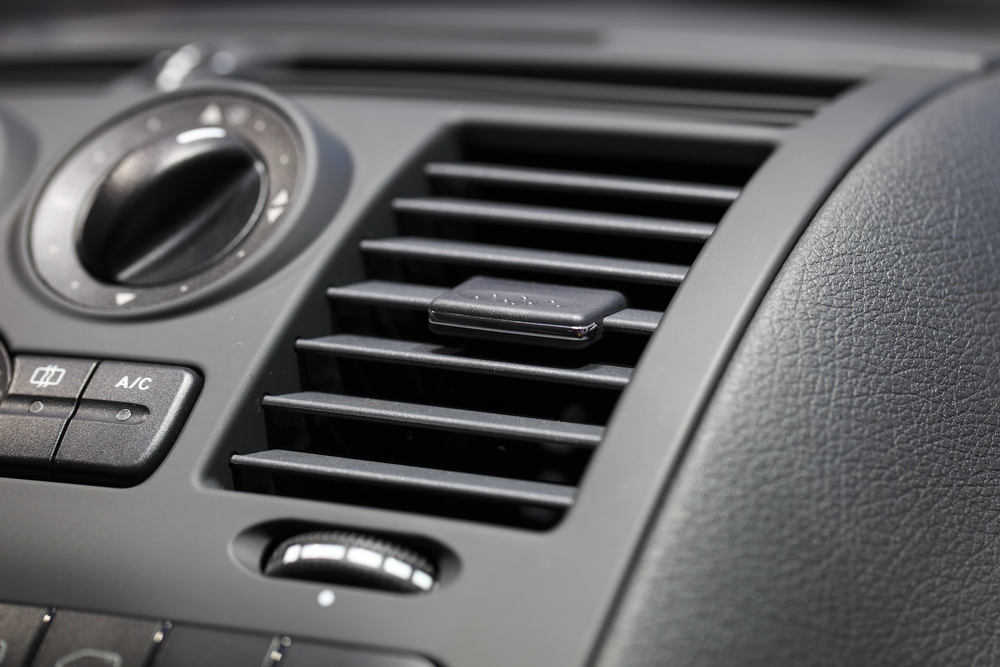
Utah summers can definitely pack a punch when it comes to high temperatures, but thanks to air conditioning systems, we don’t have to suffer while we drive. Since 1940, cool air has graced car owners, providing relief from the heat. But how exactly does it work? Here are some insights from your auto care experts at Master Muffler.
Air Conditioning Basics
Not only do air conditioners cool the air that flows into the passenger compartment, but they also remove moisture from the air, providing for a more comfortable environment inside the vehicle. In order to accomplish this, there needs to be a refrigerant that works to cool and dehumidify the air within the system. Early cars used a refrigerant known as Freon, but due to health and environmental implications, the switch was made to a substance known as R134a refrigerant. Since 1994, almost every car built is equipped with R134a.
In addition to refrigerant, here are some of the vital components of an effective air conditioning system:
1. Compressor
The compressor serves as the power unit of the air conditioning system. Its purpose is to pressurize the refrigerant before pumping it into the condenser where its state changes from gas to liquid. The compressor is powered by the serpentine belt and is the core component of any cooling system.
2. Condenser
The air-conditioning condenser is essentially a radiator positioned between the car’s grille and the engine cooling radiator. Here, the refrigerant cools down, returning to a liquid state. In short, this component is responsible for removing heat from the system, allowing the refrigerant to pass through the expansion valve smoothly, as a liquid.
3. Expansion Valve
Most cars’ A/C systems are similar, but some use what is called an orifice tube and some use a thermal expansion valve. In either case, both of these components carry out the same function: to monitor the flow of refrigerant and relieve pressure so that the refrigerant can expand into gas form. Two things work to determine a substance’s state of matter, they are heat and pressure. The expansion valve leverages pressure to vaporize the refrigerant.
4. Receiver, Drier or Accumulator
For vehicles that use an expansion valve, they will have an accumulator. For those that have an orifice tube, they will have a receiver-drier. Regardless of the name, this component of the system is designed to store and dry air conditioning refrigerant. It is located between the condenser outlet and the expansion valve inlet and works to protect the system against moisture damage.
5. Evaporator
Last but not least, the evaporator is another small radiator that introduces the cold air to the passenger with the help of a blow motor and fan. This component is usually hidden within the vehicle’s dashboard.
Air Conditioning Repair
Due to the complexity of the system, air conditioning units can be tricky to repair and typically require a bit of labor. The first step in the process is properly identifying which system component is holding up the process. If just one of the aforementioned system constituents is leaking or otherwise malfunctioning, it will usually affect the entire unit. Here are some signs that your A/C system is in need of repair:
- No Cold Air
- Weak Airflow
- Strange Noises
- Bad Odor
- Leaking Refrigerant
- Leaking Dashboard
- Air Temperature Changes From Cool to Warm
If you are experiencing any of the above problems, your air conditioning system is probably damaged. At Master Muffler, we are experts in all-things Utah auto care and can help you with your air conditioning needs. Contact us today or stop on in to any one of our 16 locations and we’ll make sure everything is in working order.
Related Posts
As an EV owner, understanding your vehicle's battery is critical. From its capacity to its lifespan, and everything in between, we'll guide you through what you need to know to optimize your EV experience. So buckle up and get ready - we're about to shed some light on the electrifying world of EV batteries. What [...]
If your car is running hot, it can be a sign that something’s not right with your engine. Fortunately, diagnosing the cause of an overheating engine isn't too difficult if you know what to look for and how to address it. Keep reading if you want to learn the most common issues that occur when [...]
Your vehicle's exhaust system serves a critical role in managing the byproducts of the combustion process and ensuring optimal engine performance. The appearance of colored smoke from the exhaust pipe, either when stationary or accelerating, can provide valuable clues to underlying mechanical issues. What is a car exhaust? A car exhaust is a system [...]





